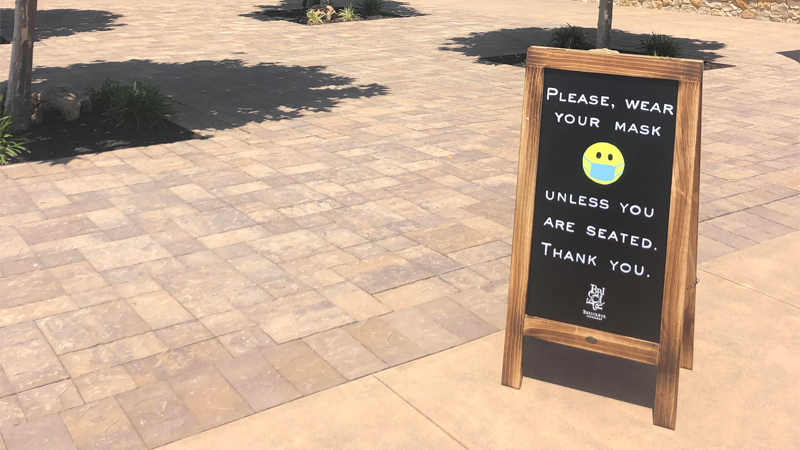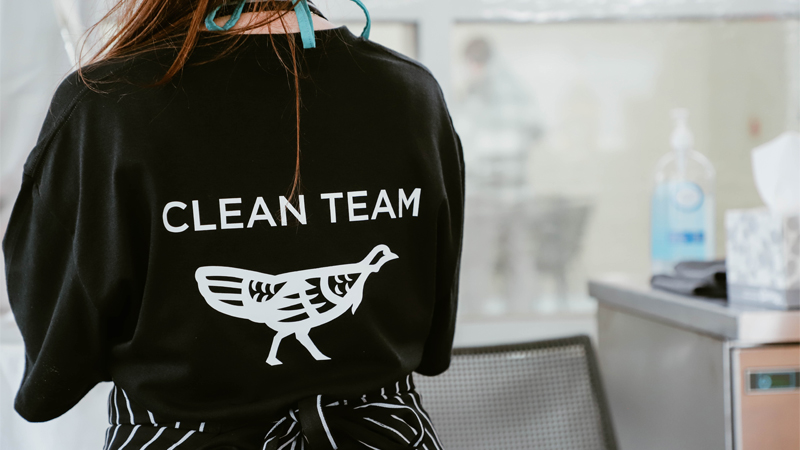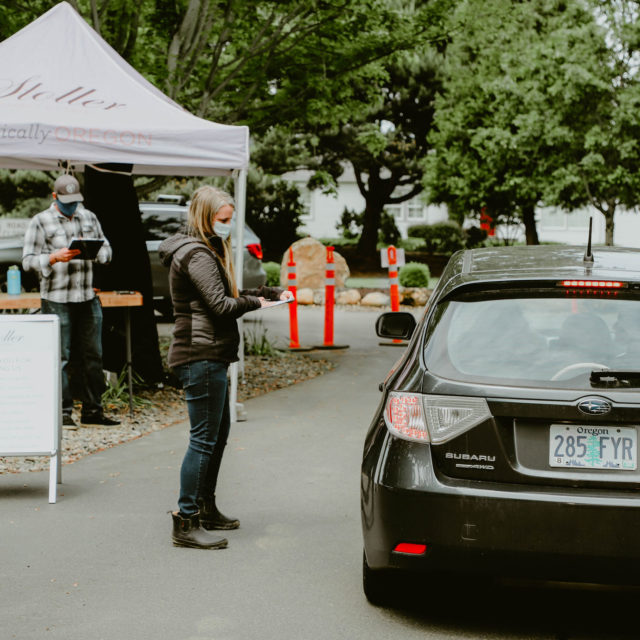When visitors arrive at Sonoma County’s newest winery, Bricoleur Vineyards in Windsor, Calif., the first thing they see is a chalkboard sign that reads, “Please wear your mask, unless you are seated,” with a masked smiley face emoji. Guests then proceed to the outdoor check-in desk, which is stocked with masks, gloves, and hand sanitizer, and are led to either a great big lawn or pavilion for a tasting experience that’s more than safely distanced from others.
Bricoleur had its grand opening slated for the first weekend in May, so when Sonoma County announced a loosening of restrictions just ahead of Memorial Day weekend that allowed wineries to reopen if they served food outside, they were ready, and quickly sold out on their limited reservations. “Everyone seems so overjoyed to leave the house,” says Mark Hanson, Bricoleur Vineyards founder and CEO.
But while wine lovers may be itching to get back to sipping among the vines, wineries have to operate in an entirely new way to ensure they are protecting the health and safety of both guests and employees. VinePair talked to several wineries that recently reopened their doors to visitors to find out how they’re navigating this new normal.
Utilizing Outdoor Space
Wineries like Bricoleur that have significant outdoor space are at a clear advantage when it comes to reopening. Not only is there a lower risk of transmission of Covid-19 outdoors, but this makes it easier to socially distance guests and enables wineries to increase their capacities, which can be significantly cut in a tasting room. “Everyone feels well beyond six feet apart. They’re totally spread out,” says Hanson.
Seated tastings are being replaced with activities that get visitors up and moving. The first winery to welcome back visitors in Sonoma County, Jordan Winery in Healdsburg, cleverly launched four-mile hikes on its sprawling, 1,200-acre estate. Visitors to La Crema Winery’s Windsor, Calif., location can embark on a self-guided walking tour of the Russian River Valley property while Donum Estate in Sonoma is offering tours of its massive outdoor sculpture collection.

Picnic offerings make these outdoor experiences as contactless as possible. Bricoleur curated a picnic for two with a bottle of wine for guests who are uncomfortable being around employees; the only contact is on initial pickup. In Utica, Ill., August Hill Winery decided to make use of a massive grassy hill at its winery, a separate location from its tasting room that’s typically closed to the public. Guests at the Wine on the Hill events climb up the hill with blankets and supplies to casually picnic with pre-ordered bottles of wine and optional food from a local restaurant.
Booker Vineyard in Paso Robles, Calif., developed a new private picnic experience at its vineyard, which Chelsea O’Grady, the winery’s DTC director, says is run like “VIP bottle service” that you might get at a club. “There’s absolutely no interaction, no people by you,” she says. “After working in the wine industry for nearly 10 years, I was thinking, what would I want to do after this pandemic? I wouldn’t want to be hassled by new procedures and worry if I was touching something I wasn’t supposed to, or if I needed to be wearing a mask. With the vineyard experience, there is no worry. Guests can arrive and relax and enjoy themselves without any other guests nearby.”
It is, however, a roll of the dice when it comes to the weather, and wineries need to have a backup plan that enables them to still adhere to new protocols. O’Grady says they encountered high winds and rain the first two weekends after reopening.
Providing a Safer Guest Experience
Staggering tasting appointments so that parties don’t arrive at the same time, using disposable or laminated tasting menus, and providing bottled water are just a few of the new ways wineries are protecting their guests. Bremer Family Winery in St. Helena, Calif., sets a glass wrapped in plastic at each place setting and Daou Vineyards in Paso Robles has even added a bathroom attendant to help manage safe traffic flow through restrooms.
Some are doing away with tasting flights in favor of by-the-glass or bottle experiences, or pre-pouring flights before guest arrival. “Pouring the entire flight at one time versus repeatedly coming out to the table and reaching right in front of a guest allows the server to stand back and walk them through the different wines without needing to be right up in that six-foot bubble,” says Tracy Timmons, vice president of consumer sales at Stoller Family Estate in Dayton, Ore. Eliminating the need for the host to stand by the table and talk altogether, Gramercy Cellars in Walla Walla, Wash., has printed QR codes on the tasting menu, which pull up short videos about each wine on guests’ phones.

O’Grady says her team installed glass tabletops on all the wooden furniture at Booker so that they “are easy to clean and guests can tell they are pristine when seated.” They also added barrels near each table to further reduce employee and guest contact. “If a group wishes, they can leave their glasses on the barrel and we can pour for them from a distance of six feet without directly approaching their table,” she says.
Adjusting to New Employee Protocols
Like servers at restaurants, winery employees now need to wear masks at all times and, in some cases, gloves. Many employers are also requiring temperature and symptom checks upon arrival. “Our workers hate wearing gloves, but that’s the rules,” says Hanson, citing Sonoma County regulations. “They make it challenging to use our point-of-sale system on the iPad. You have to make the grooves really tight, so making the gloves work with our technology has been a challenge.”
Timmons says it took her staff quite some time to adjust to wearing masks. “Talking to guests while wearing a mask, knowing they can’t see your facial expressions, that was definitely a hurdle for the team to get used to,” she says. “This was a discussion we had a lot between the team. It’s kind of like speaking to a baby with much more exaggerated facial expressions. You have to really smile with your eyes to help with that emotional connection.”
